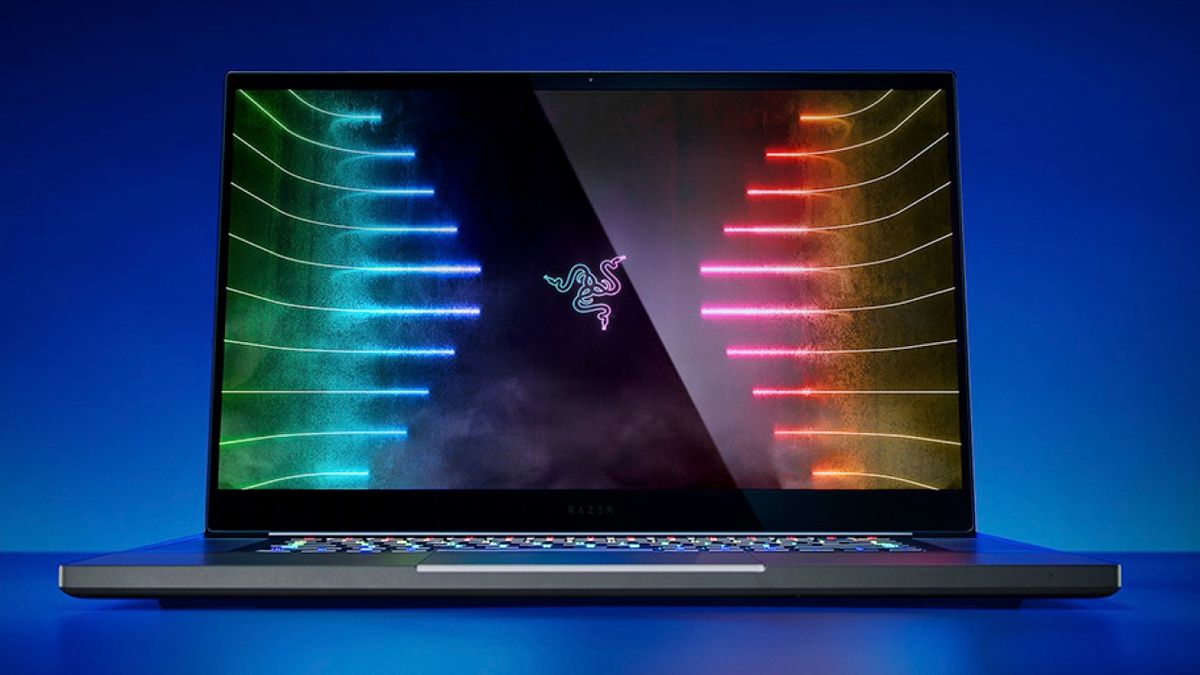12DOVE Verdict
In isolation, this is probably the best Razer laptop you can buy - if you have the budget. However, despite all the new components, it's not a silver bullet for 4K gaming and that price tag feels very, very high when you have to bump games down to 1080p.
Pros
- +
It's a 30-series gaming laptop
- +
Brand new components for cutting-edge performance
- +
Exquisite screen
- +
Excellent Razer-quality design and build
Cons
- -
Seriously expensive
- -
Can't actually game at 4K, 60fps
- -
Bumping down resolution means losing a USP of the machine - and showing that 20-series laptops can offer the same
- -
Proprietary power source
Why you can trust 12DOVE
Update: August 8, 2022 - A new version of the 17-inch Razer Blade laptop is now available, read our full review of the Razer Blade 17 2022 for more details.
All the heavy hitters are coming out with their new variants of gaming laptops this spring, unleashing a shift around on the internet's best portable powerhouse rankings. A new generation of the best graphics card and best CPUs for gaming means a new generation of the best gaming laptops, and it's now the turn of the new Razer Blade Pro 17, offering a clear window into what can be bought at the top end of Razer laptops. And it is very much at the top end: the model sent to us for review clocks in about the $3,600 / £3,300 mark. Oof.
Design & features
Processor: Intel i7-10875H
Graphics: Nvidia GeForce RTX 3080
Memory: 32GB DDR4 RAM
Display: 17.3-inch, 120Hz
Resolution: 3840 x 2160
Storage: 1TB PCIe M.2 SSD
Ports: 3 x USB 3.2 Type-A USBs; 2 x USB 3.2 Type-C USBs (shared with Thunderbolt 3 Port); 1 x Thunderbolt 3 ; 1 x RJ45 - 2.5Gb ethernet; 1 x power port; 1 x HDMI 2.1; 1 x UHS-III card reader; 3.5mm Headphgone/Microphone combo jack
Connectivity: Wi-Fi 6E (Intel AX210; 2.4GHz / 5GHz / 6GHz 802.11ax Wi-Fi); Bluetooth 5.2
OS: Windows 10 Home
Weight: 6.06lbs (2.75kg)
The star of the show in the laptop's features is, of course, the new RTX 3080 graphics card. The excitement around what RTX 3080 laptops can do has been palpable since the (full fat) graphics card was announced last year. Hailed as some sort of potential second coming given the capability of that new GPU from Nvidia, the 3080 promises a level of performance upgrade we've not seen in a long time (if ever?). It's winning a lot of people over with its brand-new GDDR6X memory as well as its ability to not only straddle the 1440p-4K divide but give a proper go at 4K gaming. In a laptop, that really is exciting.
The laptop's wider set of components complement the 3080 greatly and make for an imposing configuration: an Intel i7-10875H processor, a hefty 32GB of RAM, a spacious 1TB SSD, and a gloriously bright and vivid 17.3-inch 4K touch screen that has a 120Hz refresh rate.
While the latest in GPUs is indeed in this machine, it's worth noting that, despite the new generation of Intel's processors coming out soon, and already starting to be seen in some pre-order machines, this Blade Pro 17 still hangs on to a 10th-gen model. The i7-10875H is no slouch, of course, and certainly one that's very at home in a gaming beast from Razer, but perhaps an eyebrow raiser, given the imminent widespread availability of the 11th-gen processors which will undoubtedly go straight into some more of this year's Blade Pro 17 laptops.
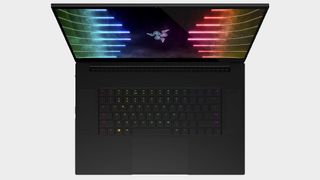
Meanwhile, it's a typical Razer laptop affair when it comes to this Blade Pro 17's design and build; this is a sleek matte black machine with accents of Razer green in the ports as usual. Despite being the larger 17.3-inch screen variant of the blade family, it's still got that (relatively) slim and light build which is an impressive feat.
The keyboard and touchpad are standard affairs, on the other hand, though the lack of a numpad, despite the large chassis, will be relevant to some folks who want that in a large portable PC.
Still, the screen will probably distract you from any disappointment. Embedded in the same chassis is an excellent display - if you can get the most out of it, that is (more on that below). The 4K 120Hz touch screen in our review model is a thing of beauty and really does look set to place the Blade Pro 17 at the top of the class. A 4K, 3080-powered machine that has a touch screen? What could be better? Well, we speak about the results more below, but there's no denying the quality of the screen and the fact that it will be a major pulling feature for those looking to set the dial to 'Premium' in every department.
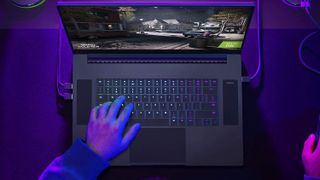
Elsewhere, other noteworthy features include the standard port setup - you'll have the usual number of USBs and visual input/output ports to get you going - and Razer's own power supply port and cable. This is a headscratcher, as you'll always be using this laptop when plugged in anyway, but the proprietary nature of this power connection means that you can't easily sub in a different cable - like the ever-increasing USB-C chargers for laptops nowadays - and you'll need to keep that Razer-own power supply wrapped in cotton wool when we all start moving around again.
Performance
How does the Razer Blade Pro 17 (2021) fare on some industry tests? We've included both 4K and 1080p resolution testing results.
Firestrike: 18825
Firestrike Extreme: 11431
Firestrike Ultra: 6430
Timespy: 9359
Timespy Extreme: 4378
Port Royal: 6090
PCMark 10: 5722
Cinebench CPU: Multi-core: 6,068cb; Single-core: 1,158cb
CrystalDiskMark: 2,790 MB/s read; 2,858 MB/s write
Tom Clancy's The Division 2: Ultra at 1080p: 59 fps; Ultra at 4K: 36 fps; High at 1080p: 60 fps; High at 4K: 49 fps
Metro Exodus: RTX (ray-tracing on Ultra) at 1080p: 57 fps; RTX at 4K: 39 fps; High at 1080p: 74 fps; High at 4K: 44 fps
Shadow of the Tomb Raider: Highest at 1080p: 83 fps; Highest at 4K: 49 fps; High at 1080p: 84 fps; High at 4K: 57 fps
Total War: Three Kingdoms: Ultra at 1080p: 83 fps; Ultra at 4K: 25 fps; High at 1080p: 113 fps; High at 4K: 37 fps
Now then, this is where it gets interesting. While some thought the 3080 graphics card would immediately make 4K, 60fps gaming available by default, our real-world testing and experiences weren't as clear-cut. At all. Squishing in a 3080 card in such a machine is impressive, and will drive great performance, but it never really offers holy grail-levels of performance, pumping out that 4K resolution at 60 frames per second or more. As our benchmarks show, while you can easily get north of 30 frames per second at that true 4K resolution, you'd have to bump the settings down considerably to get the machine to crank out 4K @ 60 fps consistently.
If you want to retain the highest graphical fidelity and highest settings, however, then you'll have to go down to 1080p - 1440p is still on its way on laptops (or you could try some weird resolutions in between 4K and 1080p but they're, well, weird). The performance at 1080p is unbelievable, of course, with everything turned up to the maximum setting, including ray-tracing effects, and it's a joy to play on as a result.
However, when you bump the resolution down to 1080p the performance is roughly the same as a 20-series powered equivalent from the past two years or so. Which is highly revealing. We tell no lies: our review of the Blade 15 Advanced (2020) from last year matches the 30-series beast at 1080p, as does the Blade Pro 17 (2019), and even our 2060 Super-powered, half-the-price-of-the-Blade-Pro-17 ASUS ROG GA15 PC matches it with the settings on max. Now, of course, those models aren't 'direct' competitors to the new 30-series-powered Blade Pro 17 laptops from Razer and, importantly, you're unlikely to ever have more than one in front of you when examining them, but the results are stark. And because of that, we are left having to view the Blade Pro 17 in two lights: in total isolation, this offers good 4K-gaming levels, and generally great gaming performance. Compared to other machines, however (and inserting the 'bumping it down to 1080p' caveat), it doesn't offer much of a jump and certainly not one that's going to be a clincher for the price tag it demands. If only it had a true 1440p resolution panel, and we might really be onto something...
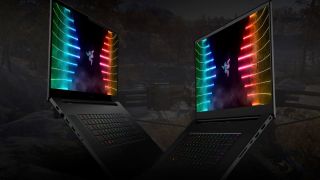
Elsewhere, I'm obliged to talk about the battery life, but we grow tired of this for gaming laptops as it just isn't an accurate measure of how people will use them. Yes, it'd be nice to have great battery life in such a device, but when unplugged you're only going to get a small handful of hours' use out of it. And honestly, that's fine given this machine's place as a desktop-replacer and portable workstation PC.
Elsewhere, the touchscreen certainly adds a premium touch, but I'm not sure exactly how this would be best used.
As a laptop to use 'normally' it's a great machine and will handle all work and home tasks easily (even well up and into creative kind of work such as high-quality video and image editing), though you'll want to team it with a top PC headset for gaming for anything audio. This productivity angle may help to justify the price tag a little, but in reality, this is likely to apply to a small number of shoppers.
Overall - should you buy it?
In conclusion, the Razer Blade Pro 17 has left me a little confused. We were extremely excited to get this in our hands as one of the first true 3080 laptops, but the performance and getting it to play nice with that 4K screen is quite nuanced and not as clear-cut. Yes, it definitely gives some of the best gaming PCs a run for their money in terms of performance, but it also outstrips some of them by a long way on price too - even when both types have the latest and newest components within.
Because of the easy comparisons to make to similar machines, and the way benchmarking makes this straightforward, and the fact that it costs so much, it's hard to judge the laptop in complete isolation. In such a case, the laptop is pretty compelling, and but as soon as you factor in the comparative data and other machines, it starts to look less rosy, particularly given that unavoidable elephant-sized price tag in the room. It's so expensive that we've heard it referred to as a laptop that's being aimed at the creative workstation market as well as the gaming one. This might sway it for some folks, but for most looking for a top gaming laptop, this will be far too expensive.
Other builds are available such as with 3060 or 3070 cards, teamed with a 360Hz 1080p screen, and we'd lean more towards those model if pushed for a decision. Beyond that, if you want an excellently competent, large Razer laptop then an older one with a 20-series card within it might be the better option. Safer still, it might pay to wait and see how the next few months play out with more and more of the newer generation of gaming laptops flexing their muscles.
Rob is the Deputy Editor of sister site, TechRadar Gaming, and has been in the games and tech industry for years. Prior to a recent stint as Gaming Editor at WePC, Rob was the Commissioning Editor for Hardware at 12DOVE, and was on the hardware team for more than four years, since its inception in late 2018. He is also a writer on games and has had work published over the last six years or so at the likes of Eurogamer, RPS, PCGN, and more. He is also a qualified landscape and garden designer, so does that in his spare time, while he is also an expert on the virtual landscapes and environments of games and loves to write about them too, including in an upcoming book on the topic!
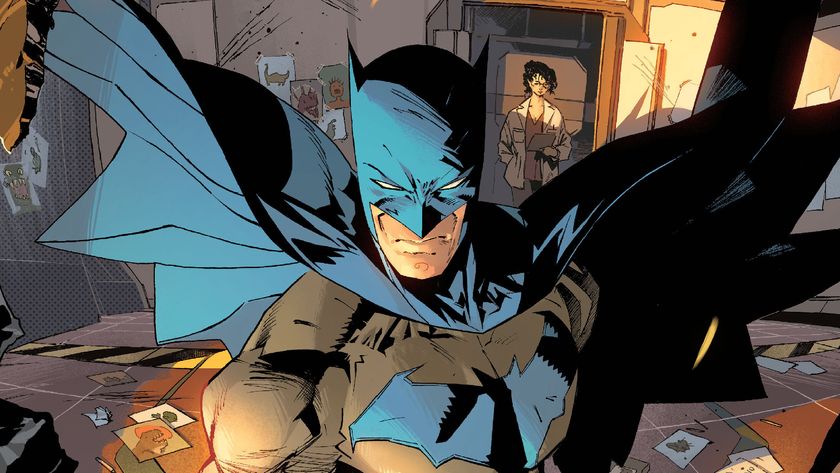
A new Batman #1 from Matt Fraction and Jorge Jiménez launches this September with a "revamped aesthetic," a throwback costume, and a new Batmobile

Marvel reveals its full slate of May 2025 comics and covers featuring the Avengers, the X-Men, Spider-Man, and more

Former Witcher 3 lead says his new vampire RPG Blood of Dawnwalker has a smaller open world because "it feels more like you actually know the place" compared to "behemoths"
Most Popular




